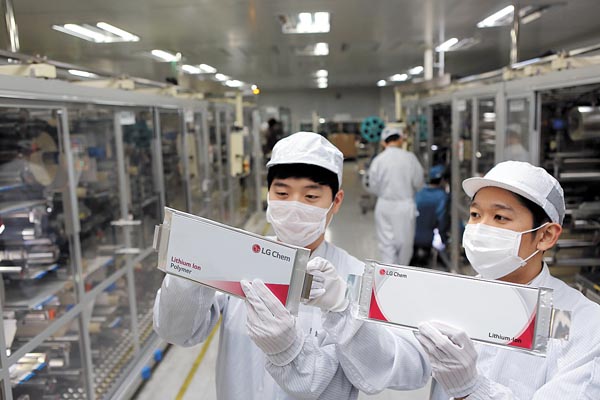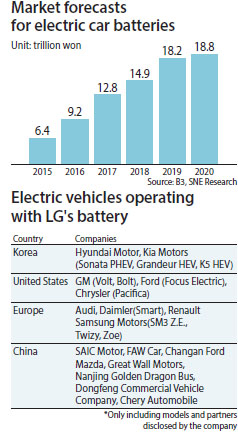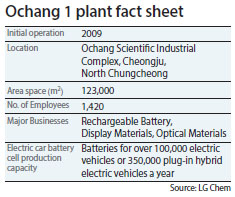Battery giant sees longer life as market surges

Workers at LG Chem’s plant in the Ochang Scientific Industrial Complex in Cheongju, North Chungcheong, check the quality of a battery cell on March 4. LG CHEM
The Korea JoongAng Daily visited the company’s manufacturing site in the Ochang Scientific Industrial Complex in Cheongju on March 4.
The Ochang plant - where the company makes lithium-ion battery cells for electric cars, along with display and optical materials - started operating in 2009. Since then, it has grown to become the most productive single facility in the world. It has the capability to produce enough battery cells daily to power 10,000 of Hyundai Motor’s Sonata hybrid electric vehicle, which adds up to 50 million battery cells a year.
Covered in blue windows, the two buildings with battery production lines occupy 123,000 square meters (30 acres) of land. Though it is a busy manufacturing plant on the inside, the first impression of the facility looks more like a research lab than a factory.
Inside the facility, most of the work is done by machines in a rapid and precise manner. Instead of the metallic sound of nuts and bolts being screwed, high-tech machines move back and forth to fit, wrap and fold batteries on a conveyer belt.
The batteries go through three processes, where mechanical arms add positive and negative poles to a battery cell, stack them into several layers and fold them for packaging. The stacking and folding is actually a patented process of the company that maximizes the energy density of each battery.
When all processes are finished, workers check the quality of the products at the end of the line and move them forward for distribution.
To maintain the ideal manufacturing environment, visitors to the plant wear protective overalls, shoe covers, a mask and a cap and go through an air shower room to blow off dust and moisture.

LG Chem first stepped into the business in the early 2000s. The Japanese leaders in the market at that time focused on producing nickel-metal hydride batteries. Thanks to LG Chem’s early investment in new battery materials, it is now moving toward making a profit.
“It took a lot of investment from the company, but we are almost at the break-even point now, and we are looking forward to surpassing it this year fast,” said Lee Jung-jae, head of the Ochang plant.
Entering a new business has been difficult, but thanks to the positive outlook in the electric car business, the company can see a speedy return on its investment. “The plant has been running 24 hours a day, seven days a week from the latter half of last year,” Lee said. “And it’s expected to continue doing so due to surging orders.”
According to B3, a Japanese market research firm, the electric car market is expected to grow into an almost 19 trillion won ($16 billion) market by 2020, a 300 percent growth from the 2015 figure of 6.4 trillion won. The forecast is based on increasing worldwide demand for more eco-friendly cars, as regulations for car emissions become stricter in global markets.
When LG Chem first embarked on the electric car battery business, it only brought in about 60 billion won in revenue. However, the business grew to roughly 700 billion won last year and is forecast to increase to 1.2 trillion won this year.
The company currently supplies batteries to over 20 companies worldwide, including General Motors, Renault Samsung Motors, Hyundai Motor, Audi and Volvo.
“Preemptive change is what led the history of LG Chem,” said Park Jin-su, vice chairman and CEO of the company. “Many complain we are facing an economic crisis these days, but there have always been challenges from time to time.”

“In 1951, we jumped into the plastic business even though it was wartime in Korea [during the Korean War from 1950-53] and in the 1990s, we went into the battery business,” he said. “We will keep our pioneering DNA to pursue even stronger changes amid market uncertainties.”
Park said the company will focus on energy, water and bio in the future.
While the company has already established the energy and water business, the bio sector is a relatively new approach for the company.
“We are considering various options, including mergers and acquisitions, to find a new business opportunity in the bio sector,” Park said.
The company is in the process of acquiring Dongbu Farm Hannong, crop protection products maker. Industry insiders predict the company’s moves in the bio sector will involve Dongbu.
As an example of the company’s development plans for its battery business, Park said, “Imagine revolutionary batteries that can power electric cars to move over 500 kilometers [310 miles] on a single charge.” Currently, LG Chem’s battery can power an electric car up to 320 kilometers on a single charge.
For the water business, the company plans to inject 40 billion won to add another production line to its existing water filter facility. Its filter utilizes reverse osmosis to filter water for industrial and home use and also to desalinate seawater. The company first began its water business in 2014.
BY KIM JEE-HEE [kim.jeehee@joongang.co.kr]










with the Korea JoongAng Daily
To write comments, please log in to one of the accounts.
Standards Board Policy (0/250자)